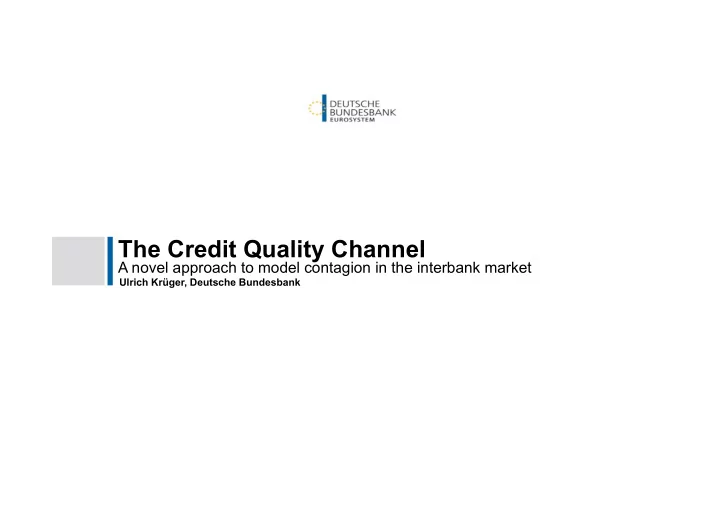

The Credit Quality Channel A novel approach to model contagion in the interbank market Ulrich Krüger, Deutsche Bundesbank
Motivation and general approach • Analysis of contagion effects due to a deterioration in credit quality in the banking network Credit event in the banking network Transmission of the shock to other banks via asset devaluation and deterioration in credit quality Adverse effect on Tier 1 capital derived from Basel accords Reduction in aggregated Tier 1 capital in the banking system due to an exogenous shock • “Banking System Loss” (BSLoss) measures interconnectedness Extends existing default cascade models (sensitivity to small shocks) Deutsche Bundesbank 23 February 2016 Page 2
Illustration of the contagion process Second and higher order round First round effects External shock effects (k ≤ 3) (k=2) Bank 2 (k=1 ) � � � � � � �,� Bank 1 �,� Bank 4 � �,� � � � � � � � � Tier1Rat … … � � �,� RWA increase, �,� � �,� 6% reduction in ����1 � … � �,� � �,� Tier 1 capital … PD 2 < 1 … Tier1Rat Tier1Rat Bank 3 … 6% ����1 � ����1 � 6% � � � � � � �,� �,� PD 1 = 1 PD 4 < 1 � �,� … Tier1Rat … 6% ����1 � PD 3 < 1 Deutsche Bundesbank 23 February 2016 Page 3
Conceptual description • Capital ratios of banks in the network (bank 2, bank, 3, bank 4 in the example) change through contagion Change to Tier 1 capital is translated into an increase of the Probability of Default (PD) Expected losses of the neighboring banks are deducted from their Tier 1 capital (consistent with Basel accord) • “Banking System Loss” measures interconnectedness Reduction in aggregated Tier 1 capital in the banking system due to the exogenous shock Deutsche Bundesbank 23 February 2016 Page 4
Application Network of German banks • Data as of end of December 2013 from Deutsche Bundesbank’s credit register of large exposures (€1.5m or more) Deutsche Bundesbank 23 February 2016 Page 5
Application I Ranking of systemically important institutions Rank Total Effect Indirect Effect of BSLoss / direct BSLoss Defaults BSLoss Defaults Inst. Exp. 1 1 5.51 92% 96% 1 1 1 7.19 94% 96% 2 1 1 4.68 90% 95% 3 0.34 0.69 1.23 64% 21% 4 0.11 0.02 0.94 53% 54% 5 6 0.09 0.02 0.76 41% 27% 7 0.08 0.03 0.73 38% 17% 8 0.07 0.12 0.69 35% 2% • “BSLoss” normalised by BSLoss of the highest ranked bank (bank 1) • Number of defaults of banks in the contagion process shown in relation to the number of defaults following the default of bank 1 Deutsche Bundesbank 23 February 2016 Page 6
Benchmarking with other measures of interconnectedness D-SIBs D-SIBs Bonacich In-Degree (Total score) (Interconnec- centrality measure tedness) ρ 39 % 66 % 96 % 70 % • ρ shows Spearman’s rank correlation coefficient between BSLoss and other measures • Low correlation with D-SIBs’ methodology for interconnectedness due to restrictions to direct exposures • High correlation with Bonacich eigenvector-based centrality underlines that both measures take into account the entire network structure Deutsche Bundesbank 23 February 2016 Page 7
Application II Shock to the real estate sector Deutsche Bundesbank 23 February 2016 Page 8
Conclusion • Merits “BSLoss” easy to interpret (expressed in monetary units) Sensitive to small shocks Allows for different credit stress scenarios shock to one bank or a group of banks shock to the mortgage sector or to other sectors Supports evaluation of macroprudential instruments (eg SIFI-buffer) • Limitations Ignores impact from other relevant contagion channels (liquidity channel, reputation channel etc.) Deutsche Bundesbank 23 February 2016 Page 9
References Alter, A., B. Craig, and P. Raupach (2015). Centrality-based capital allocations. Discussion Paper Deutsche Bundesbank 03/2015. Craig, B., and G von Peter (2010). Interbank Tiering and Money Center Banks. BIS Working Paper 322. Fink, K., Krüger, U., Meller, B., Wong, L.H. (2015). The credit quality channel: modeling contagion in the interbank market. Discussion Paper Deutsche Bundesbank 38/2015. Marquez-Diez-Canedo, and S. Martinez-Jaramillo (2009). A network model of systemic risk: stress testing the banking system. Intell. Sys. Acc. Fin. Mgmt. 16. Gauthier, C., A. Lehar, and M. Souissi (2010). Macroprudential Regulation and Systemic Capital Requirements, Bank of Canada Working Paper 4/2010. Martinez-Jaramillo, S., B. Alexandrova-Kabadjova, B. Bravo-Benitez, and J. P. Solorzano-Margain (2014). An empirical study of the Mexican banking system’s network and its implications for systemic risk. Journal of Economics Dynamics and Control 1. Martinez-Jaramillo, S., O.P. Pérez, and F.A. Embriz, and F.L.G. Dey (2010). Systemic risk, financial contagion and financial fragility, Journal of Economic Dynamics & Control 34. Memmel, C., A. Sachs and I. Stein (2012), Contagion at the Interbank Market with stochastic Loss Given Default, International Journal of Central Banking, Vol. 8(3), 177-206. Georgiescu, O.-M. (2015). Contagion in the Interbank Market: Funding versus Regulatory Constraints. Available at SSRN http://ssrn.com.abstract=2271545 or http://dx.doi.org/10.2139/ssrn.2271545. Deutsche Bundesbank 23 February 2016 Page 10
Appendix: The credit quality channel in the context of stress testing Credit quality channel Scenario analysis Satellite models Exogenous Interbank Income components shock contagion net interest income net fee income trading income operating expenses Economy Financial stability GDP-growth, Credit risk Impact on losses of the interest rates, credit losses banks financial sector unemployment rates change in RWA etc. feedback effects Deutsche Bundesbank 23 February 2016 Page 11
Appendix: Relationship between Tier capital ratio and Probability of Default • Impact of banks’ Tier1 capital ratio on its PDs derived from a univariate logit-regression �� �,� � � � � � ∙ �� ������ �,��� �� �,� : Probability that bank � will fail in time � � 1; � ⁄ ������ �,� : Tier 1 Capital Ratio ( ����1 �,� ��� �,� � � ��� : Cumulative logistic distribution ( � � �1 � � � � ⁄ ) Deutsche Bundesbank 23 February 2016 Page 12
Appendix: Assessing shock transmission for different types of banks Deutsche Bundesbank 23 February 2016 Page 13
Recommend
More recommend